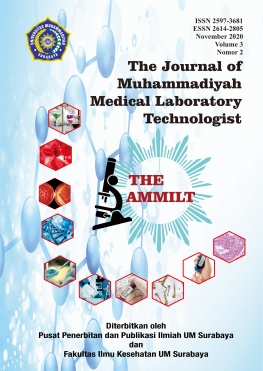Isi Artikel Utama
Abstrak
The aim of the study was to see the comparison of urea and creatinine levels in chronic kidney disease patients between those infected with malaria and those not infected with malaria at the Jayapura Regional General Hospital. This type of research is retrospective analytic. The samples of this study were chronic kidney patients who were infected with malaria and conducted an examination at the Jayapura Regional General Hospital that met the inclusion criteria, in order to obtain 30 positive malaria samples. The average urea level of female CKD patients infected with malaria was 116.7 mg/dL, the lowest was 63,8 mg/dL and the highest was 136,2 mg/dL. The average urea level of male CKD patients infected with malaria was 95,9 mg/dL, the lowest was 33.4 mg/dL and the highest was 231,0 mg/dL. The result of the mean creatinine level of female CKD patients infected with malaria was 17,5 mg/dL, the lowest was 9,92 mg/dL and the highest was 31,38 mg/dL. While the mean creatinine level of male CKD patients infected with malaria was 12,0 mg/dL, the lowest was 3,49 mg/dL and the highest was 26,27 mg/dL.
Rincian Artikel
Referensi
- Akhsin, Z. 2011. Parasitologi. Yogyakarta: Nuha Medika.
- Asri. S, Puspita. D, Rosyadi. I. 2013 Perbedaan Kadar Ureum & Creatinin Pada Klien Yang Menjalani Hemodialisa Dengan Hollow Fiber Baru Dan Hollow Fiber Re Use Di Rsud Ungaran Jurnal Keperawatan Medikal Bedah . Volume 1 (1): 15-24.
- Astuti, Anggorowati, Kusuma. 2017. Self Management Terhadap Psychosocial Adjustment Pasien Penyakit Ginjal Kronis Dengan Hemodialisa. Jurnal Keperawatan Soedirman (The Soedirman Journal of Nursing), 12 (3): 181-189.
- Darmawaty. Fitriani, M. Pakasi. R, Hardjoeno. 2008. Gambaran Fungsi Hati Dan Ginjal Pada Penderita Malaria. Indonesian Journal of Clinical Pathology and Medical Laboratory, Vol. 15 (1): 1-4.
- Efraim. S, Melati. S, Eddy. 2019. Efek Jus Pisang Tongka Langit (Musa troglodytarum) Terhadap Ginjal Mencit (Mus musculus) Model Malaria. Jurnal Ilmu-ilmu MIPA. 19 (2): 154-168.
- Harijanto PN. Malaria. Dalam: Sudoyo AW, Setiyohadi B, Alwi I, Simadibrata M, Setiati S, ed. Buku Ajar Ilmu Penyakit Dalam. Jilid II Edisi V. Jakarta: Pusat Penerbitan Ilmu Penyakit Dalam Fakultas Kedokteran.
- Isa, Rinidar, Sugito. 2012. Aktivitas Antiplasmodium Daun Sernai (Wedelia Biflora) Berdasarkan Evaluasi Fungsi Ginjal dan Hati pada Mencit yang Diinfeksi dengan Plasmodium berghei. Jurnal Veteriner, 13 (2): 167-175.
- Josephine D, H. T. Rinonce, M, F, Pudjohartono, P. Astari, M. G. Winata, dan F. Kasim. 2018. Prevalensi malaria di Asmat, Papua: Gambaran situasi terkini di daerah endemik tinggi. Journal of Community Empowerment for Health, 1 (1): 11-19.
- Nasir, A, B, D. A, Muhith. M, E, Ideputri. 2018. Metodologi Penelitian Kesehatan. Yogyakarta: Nuha Medika.
- Nursalam. 2013. Metodologi Penelitian Kesehatan. Jakarta: PT Rineka Cipta.
- Peraturan Menteri Kesehatan Republik Indonesia. 2013. PERMENKES Nomor 5 tahun 2013 Tentang Pedoman Tata Laksana Malaria.
- Siregar, M, L. 2015. Malaria berat dengan berbagai komplikasi.Jurnal Kedokteran Syah Kuala. 15 (3): 149-156.
- Sitifa, A, S. Azmi, M. Yanni. 2018. Gambaran Klinis Penderita Penyakit Ginjal Kronik yang Menjalani Hemodialisis di RSUP Dr. M. Djamil Padang. Jurnal Kesehatan Andalas. 7 (1): 42-50.
- Sitti, H. 2018. Analisis Perbandingan Hasil Pemeriksaan Kreatinin Darah Dengan Deproteinisasi Dan Nondeproteinisasi Metode Jaffe Reaction. Jurnal Media Analis Kesehatan. 1 (1): 26-31.
- Suryawan, D, G, A. I. A. M. S. Arjani, I. G. Sudarmanto. 2016. Gambaran Kadar Ureum Dan Kreatinin Serum Pada Pasien Gagal Ginjal Kronis Yang Menjalani Terapi Hemodialisis di RSUD Sanjiwani Gianyar. jurnal 4 (2): 145-153.
Referensi
Akhsin, Z. 2011. Parasitologi. Yogyakarta: Nuha Medika.
Asri. S, Puspita. D, Rosyadi. I. 2013 Perbedaan Kadar Ureum & Creatinin Pada Klien Yang Menjalani Hemodialisa Dengan Hollow Fiber Baru Dan Hollow Fiber Re Use Di Rsud Ungaran Jurnal Keperawatan Medikal Bedah . Volume 1 (1): 15-24.
Astuti, Anggorowati, Kusuma. 2017. Self Management Terhadap Psychosocial Adjustment Pasien Penyakit Ginjal Kronis Dengan Hemodialisa. Jurnal Keperawatan Soedirman (The Soedirman Journal of Nursing), 12 (3): 181-189.
Darmawaty. Fitriani, M. Pakasi. R, Hardjoeno. 2008. Gambaran Fungsi Hati Dan Ginjal Pada Penderita Malaria. Indonesian Journal of Clinical Pathology and Medical Laboratory, Vol. 15 (1): 1-4.
Efraim. S, Melati. S, Eddy. 2019. Efek Jus Pisang Tongka Langit (Musa troglodytarum) Terhadap Ginjal Mencit (Mus musculus) Model Malaria. Jurnal Ilmu-ilmu MIPA. 19 (2): 154-168.
Harijanto PN. Malaria. Dalam: Sudoyo AW, Setiyohadi B, Alwi I, Simadibrata M, Setiati S, ed. Buku Ajar Ilmu Penyakit Dalam. Jilid II Edisi V. Jakarta: Pusat Penerbitan Ilmu Penyakit Dalam Fakultas Kedokteran.
Isa, Rinidar, Sugito. 2012. Aktivitas Antiplasmodium Daun Sernai (Wedelia Biflora) Berdasarkan Evaluasi Fungsi Ginjal dan Hati pada Mencit yang Diinfeksi dengan Plasmodium berghei. Jurnal Veteriner, 13 (2): 167-175.
Josephine D, H. T. Rinonce, M, F, Pudjohartono, P. Astari, M. G. Winata, dan F. Kasim. 2018. Prevalensi malaria di Asmat, Papua: Gambaran situasi terkini di daerah endemik tinggi. Journal of Community Empowerment for Health, 1 (1): 11-19.
Nasir, A, B, D. A, Muhith. M, E, Ideputri. 2018. Metodologi Penelitian Kesehatan. Yogyakarta: Nuha Medika.
Nursalam. 2013. Metodologi Penelitian Kesehatan. Jakarta: PT Rineka Cipta.
Peraturan Menteri Kesehatan Republik Indonesia. 2013. PERMENKES Nomor 5 tahun 2013 Tentang Pedoman Tata Laksana Malaria.
Siregar, M, L. 2015. Malaria berat dengan berbagai komplikasi.Jurnal Kedokteran Syah Kuala. 15 (3): 149-156.
Sitifa, A, S. Azmi, M. Yanni. 2018. Gambaran Klinis Penderita Penyakit Ginjal Kronik yang Menjalani Hemodialisis di RSUP Dr. M. Djamil Padang. Jurnal Kesehatan Andalas. 7 (1): 42-50.
Sitti, H. 2018. Analisis Perbandingan Hasil Pemeriksaan Kreatinin Darah Dengan Deproteinisasi Dan Nondeproteinisasi Metode Jaffe Reaction. Jurnal Media Analis Kesehatan. 1 (1): 26-31.
Suryawan, D, G, A. I. A. M. S. Arjani, I. G. Sudarmanto. 2016. Gambaran Kadar Ureum Dan Kreatinin Serum Pada Pasien Gagal Ginjal Kronis Yang Menjalani Terapi Hemodialisis di RSUD Sanjiwani Gianyar. jurnal 4 (2): 145-153.

